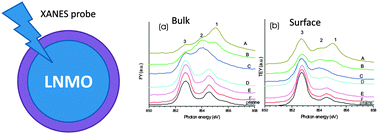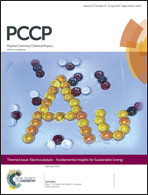Electronic structure variation of the surface and bulk of a LiNi0.5Mn1.5O4 cathode as a function of state of charge: X-ray absorption spectroscopic study
Abstract
The electronic structure at the Ni, Mn and O sites and their evolution upon the electrochemical lithiation of Li1−xNi0.5Mn1.5O4 (LNMO) in a lithium ion battery has been explored using comprehensive X-ray absorption near edge structure spectroscopy (XANES) at the Ni and Mn L3,2- and O K-edges, with both surface-sensitive and bulk-sensitive detection. It has confirmed that Ni reduction from Ni4+ to Ni2+ plays the leading role in charge compensation when the lithiation voltage is above 4.5 V. Our study also unveils the participation of oxygen in the charge compensation. Furthermore, the enhanced difference in the electronic structures of the surface and bulk in electrochemically cycled samples, and the different surface electronic structures of the fully discharged LNMO and the pristine one, highlight the importance of electrochemical activation. These findings are critical for a better understanding of the electrochemical reaction of LNMO and the influence of structural modifications to the surface region upon its performance, and will assist further efforts to improve this high-voltage cathode material for its application in lithium ion batteries.


 Please wait while we load your content...
Please wait while we load your content...